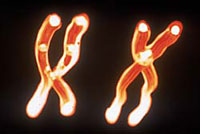Father of 1.5 million Russians lived 2,500 years ago
The Y-chromosome has no couple in the chromosome set, so it has no object for exchanging genetic material. But for mutations these chromosomes would have been inherited from fathers to sons unchanged in the history of mankind. The mutation rate is very low for many areas, and the DNA chain varies just slightly with ethnic groups having little in common. There are just few areas where such distinctions are registered. It is likely that one variant appeared as a result of mutations some time ago and was later spread in related ethnic groups.

However there are other sectors of the Y-chromosome where mutations are more frequent, so-called micro-satellite repeats for example. Such a repeat is a fragment consisting of two, three or four nucleotides. The probability of a mutation is higher for sectors of the chromosome with a great number of similar repeats one after another. Study of markers that do not change in the course of time together with markers able to mutate gives more opportunities for investigation of nations’ history.
Let us imagine a typical situation of the origin of a nation. A small group of people where the majority is relatives segregate and settle in a new place independently. Probably just one of them has a unique rare variant of the Y-chromosome with an atypical nucleotide in some position. This chromosome has a definite variant of micro-satellite repeats. When the population increases in the course of time the number of descendants having this rare mutation also increases; the number of chromosomes having this point mutation gets higher as well (it is likely however that their number does not increase at all). As time goes by the chromosomes marked with the mutation fix more mutations in their micro-satellite repeats. Accumulation of these mutations is like sand-glass that allows studying the history of offspring of the chromosome that once registered a unique point mutation.
To use the sand-glass properly one should be sure that the rate of mutations is steady. But this issue is particularly questionable.
Finns, the close relatives of some ethnic groups of Russia’s Urals Region registered a high frequency of Y-chromosomes with thymidine (T-allele) replaced with cytosine (C-allele) in a definite sector of the chromosome. And this substitution has never been registered in other countries of Western Europe, North America or Australia. But Finns were not the only people having C-allele in the chromosome. Some other Asian ethnic groups, Buryats for instance, also had it. What do blond European Finns and Mongoloid Buryats have in common? The common Y-chromosome frequently registeredwithboth nations indicates that they are genetic relatives. May it be so? There are territories between Finland and Buryatia that are inhabited with different peoples related to Finns and Buryats.
A closer study of the history of various peoples in Siberia and Europe opens up two geographic zones that within tens of centuries gave rise to new ethnic groups.
One zone is a steppe belt that stretches from the Far East to Hungary. This is where waves of people from southern countries, the stronghold of ancient civilizations, came to. That was the area from where Indo-European nomads arrived to the west thus forming the modern ethnic landscape of Europe. The other zone is the Middle Asia, the area of ethnogeny of the Chinese and Mongoloid tribes. For a rather long period of time the two ethnic communities bordered just on their peripheries, but eventually Mongoloid tribes penetrated into the Euro-Asian steppe and contributed to the genetic structure of many of modern peoples inhabiting Siberia and the Urals Region. Devastating wars, merging of various ethnic groups were the basic mechanisms that made some ethnic groups disappear and other new groups appear.
Northwards in taiga and tundra we can see a different world. Nomads did not flood the areas as hunting and fishing could not nourish as much people as steppe could. So, the areas had a different ethnogeny. Now there live descendants of ancient ethnic groups whose ancestors vanished long ago.
A study of the Y-chromosomes of Russians turned out to be a real surprise! The Y-chromosome with C-allele has been fixed with 17 percent of men who consider themselves ethnic Russians and have family names typical of Russians. This share is just slightly less than that with Mari, Mordvinians, Komi, Udmurts and Chuvash living on the Russian territory. Their micro-satellite sets turned out to be similar. About 15 million of Russians, every sixth man is a direct descendant of one man in the male line. The fact is rather unusual as there are no chromosomes with C-allele in Central Europe from where Slavic tribes came, so it is unlikely that Slavs had brought it from Europe.
We will clearly see the origin of the Y-chromosome having the C-allele if read chronicles. The data we posses allow to suppose that the Finno-Ugric component is rather big with Russians and is probably more than a half. But the discovery seems to be no surprise for historians and anthropologists. Russians are the heirs of two different ethnic groups distant from each other. And this probably explains the unique phenomenon of the mysterious Russian soul.
Translated by Maria Gousseva
Pravda.ru
Subscribe to Pravda.Ru Telegram channel, Facebook, RSS!


